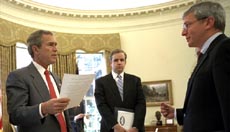
|
Advancing the Strategic Management of Human Capital
The General Services Administration (GSA) joined the ranks of "Green" agencies in the area of Strategic Management of Human Capital, bringing the total to 16 agencies that have achieved the President's vision for people management in Government. GSA's performance in human capital is anchored by noteworthy achievements in closing competency gaps in mission-critical occupations and restructuring its organization to create greater efficiencies and cost savings. As it continues to leverage itself as a premier acquisition agency, GSA's leadership programs have established the foundation for building highly competent leaders and leadership pipelines. Over 91% of the agency's leadership vacancies have been filled by internal GSA employees. The organization is also ensuring it can sustain its human capital results into the future by institutionalizing numerous human capital practices. GSA's human capital accountability system is in place to support continuous improvement through a thorough examination of human capital programs and results. Assessing Agency Human Capital Programs and Practices An overarching goal of the strategic human capital initiative is to help agencies institutionalize sound human capital management practices, which includes fully implementing a human capital accountability system. To support agencies in this effort, OPM has established an accountability community of practices. The community, comprised of agency leaders in the field of human capital accountability, is working together to develop and share strategies for using agency accountability systems to measure and improve human capital performance and programs. This year, all PMA-scored agencies will submit annual Human Capital Management Reports (HCMR). The HCMR will include a set of required metrics for measuring performance, and agencies will use reported outcomes to inform their future human capital efforts. Agencies must submit the reports to OPM by December 15, 2007. Improving Performance Management Federal agencies have significantly improved their performance management systems through the use of "performance pilots" - organizations within an agency that test and improve performance management practices. Now, agencies are expanding these performance pilots to cover more employees under effective performance management systems. These expanded pilots must demonstrate effectiveness by June 30, 2008. By mid-2009, we expect agencies to improve all their performance management systems to an effective level, as evidenced by OPM's Performance Appraisal Assessment Tool (PAAT). Agencies are also making significant improvements to their Senior Executive Service (SES) performance-oriented pay systems. As of the third quarter of fiscal year 2007, the number of systems that meet the two-year certification criteria (the highest certification level) has jumped from two percent in 2006, to 33 percent in calendar year 2007. Federal Competency Assessment Tools This quarter agencies set competency gap targets for HRM professionals as a key strategy for improving human capital management. Earlier this year, the Office of Personnel Management released two Federal Competency Assessment Tools (FCAT) to aid agencies in assessing the skill level of leaders and human resource management professionals. Over 30,000 individuals from approximately 30 Federal agencies completed assessments prior to September 1, 2007. Many agencies used FCAT-HR to set HRM targets this quarter, and agencies will submit competency targets and staff projections for their leadership cadre by December 15, 2007. Currently, OPM is analyzing the results from the competency assessment to determine what, if any, government-wide gap closure initiatives are needed. In addition, OPM is working with agencies to refine the assessment tools and plans to expand access to more Federal employees next year. Closing Competency Gaps in the Information Technology Profession On September 1, 2007, 25 agencies submitted progress reports showing their results in closing competency gaps for Information Technology (IT) Specialists since May 1, 2007. In May, each agency submitted a gap analysis report and improvement plan based on data collected by a government-wide survey of the IT workforce proficiency level. The reports described each agency's areas for improvement and their plans to continue shaping their IT workforce to meet evolving needs. The progress reports showed that all 25 agencies met their targets and milestones to date and are well along to meeting their June 30, 2008 competency gap closure targets and staffing projections. Hiring Toolkit In September 2007, OPM released version 2.0 of the Hiring Toolkit, http://www.opm.gov/hiringtoolkit/ with upgrades designed to support continuous improvement to agency hiring processes. Enhancements include a Hiring/Recruitment Video library featuring four new HR Flexibility web-streaming videos. To help agencies develop customized assessment strategies, a "Principles of Assessment" web-streaming video was created; and a link was added to the Personnel Assessment Resource Center featuring a comprehensive Assessment Decision Tool. Using this tool and other resources, the Government continues to make strides in reforming its hiring processes. As of July 1, 2007, 78 percent of hiring decisions are made and 89 percent of applicants are notified of their final status within 45 days. Showcasing Government Best Practices The Office of Personnel Management conducted a series of "best practices" forums to support agencies in talent and leadership management. On July 25, 2007, OPM conducted separate forums on analyzing competency data and setting targets for reducing competency gaps in mission critical occupations. A third forum on developing succession management programs was held on September 26, 2007. Paunee Grupe, Director of Information Technology Workforce Planning, Department of Veterans Affairs, spoke at the forum on analyzing competency data. Ms. Grupe outlined tips and techniques for using technology to manage human capital data. The session drew nearly 90 attendees from 34 agencies. Lois Gruendl, representing the Department of Defense, and Annette Moore, management analyst, Department of State, highlighted strategies for setting realistic and measurable targets at the second forum. 72 people representing 27 agencies attended this forum. The succession management forum featured Colonel Michael Harris, Department of the Army, and Loarence Bifareti, Department of Veterans Affairs. Each speaker shared insights on how their agencies are building succession management programs focused on sustaining leadership and staff capacity. OPM plans to continue its best practices forum series during the upcoming year.
More Information |